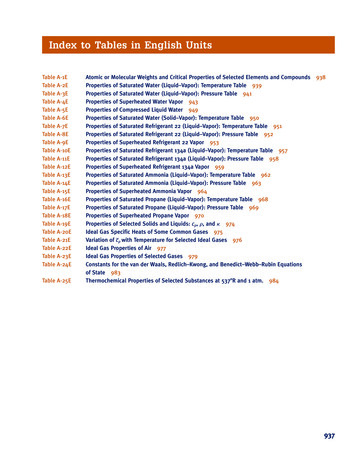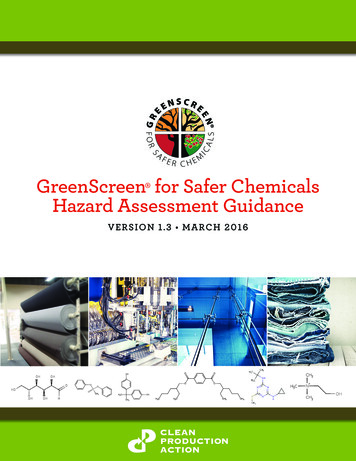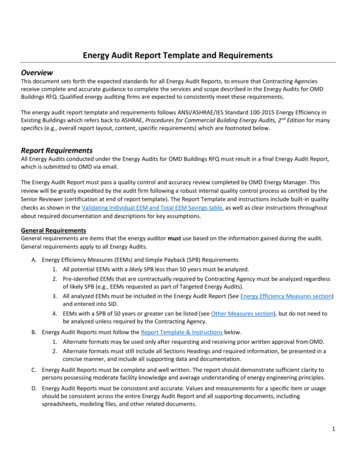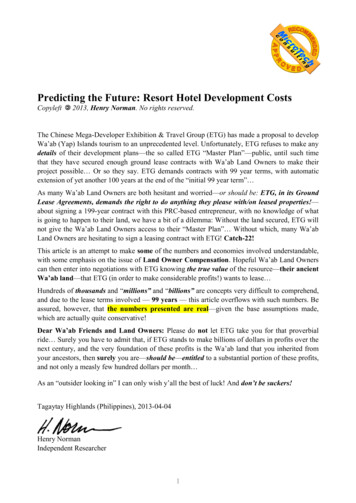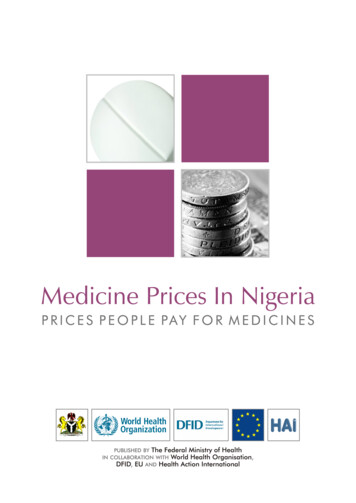
Transcription
TABLE OF CONTENTSAcknowledgements. 2Acronyms . 3Acronyms . 3Foreword . 4EXECUTIVE SUMMARY . 5INTRODUCTION AND BACKGROUND:. 8METHODOLOGY:. 12FINDINGS: . 16DISCUSSIONS: . 35CONCLUSIONS. 38ANNEXES. 41Annex 1: Completed National Pharmaceutical Sector Form. 42Annex 2: List of medicines surveyed (Product table) . 46Annex 3: Pre-survey determination of Core and Supplementary lists . 48Annex 4: Analysis summary sheets. 53Annex 5: List of Medicines on the essential medicines list . 62Annex 6: List of facilities and outlets sampled . 63Annex 7: Timetable of survey . 64Annex 8: Medicine Price Data Collection form. 651
AcknowledgementsWe are grateful to the following persons who made invaluable contributions in the realisation ofthis study:Prof. Eyitayo Lambo, Honourable Minister of HealthMr. R. K. Omotayo, Director, Food and Drug Services,Mr. Joel Adagadzu, Deputy Director and focal point, Food and Drug ServicesThe Members of the Advisory Committee who are representatives of the following:Pharmaceutical Society of Nigeria (PSN),Pharmacist’s Council of Nigeria (PCN),The Pharmaceutical Manufacturing Group of the Manufacturer’s Association of Nigeria (PMGMAN), Association of Community Pharmacists,The Nigerian Medical Association (NMA),National Agency for Food and Drug Administration and Control,Food and Drug Services,Department of Public HealthDepartment of Hospital Services.Commissioners, Directors of Pharmaceutical Services and Heads of Health Facilities visited inAnambra, Borno, Cross River, Federal Capital Territory, Kano and Lagos States.Consultants:Mr. Martin AutonDr. Catherine AdegokeHealth Action International:Margaret Ewen, Director, HAI EuropeWorld Health Organisation:Dr. Mohammed Belhocine, WHO Representative NigeriaDr. Gilles Forte TCM/HQMr. Abayneh Desta EDM/AFRODr. Ogori Taylor EDM/NigeriaThe European Union (EU)Department for International Development (DFID)2
WHOAntiretroviral TherapyAntiretroviralCost, Insurance, FreightCentral Medical StoresDrug Revolving FundEssential Drugs ListFederal Capital TerritoryGross Domestic ProductHealth Action InternationalInnovator BrandLocal Government AreaLowest Priced GenericMillennium Development GoalsMedian Price RatioMost Sold GenericManagement Sciences for HealthManufacturer’s Unit PriceNational Agency for Food and Drug Administration and ControlNon Governmental OrganisationNational Health Insurance SchemeNigerian Medical AssociationPharmacists Council of NigeriaPharmaceutical Manufacturing Group of the Manufacturers’ Association of NigeriaPharmaceutical Society of NigeriaSector Median Unit PriceStandard Treatment GuidelinesUnited StatesUnited States DollarWorld Health Organisation3
ForewordNigeria was one of the eight African countries selected to conduct National Medicines PriceSurvey in 2004 in order to determine the prices people pay for their medicines. The exercise wassponsored by the World Health Organization (WHO) and Health Action International (HAI)following observations that the cost of medicines has been rising faster than overall consumerprices in a number of countries worldwide. The prices of medicines are generally high and areunaffordable for large sectors of the global population making access to essential medicines verydifficult.The situation in Nigeria is not different and this portends a lot of difficulties for us in the healthsector in our determination to provide effective healthcare delivery services in line with theobjectives of the Millennium Development Goals (MDGs). The availability, affordability andaccessibility of essential medicines to the populace irrespective of their income status is criticalto the success of our healthcare delivery services. It is for this reason that the Federal Ministry ofHealth gave its full support to the conduct of the National Medicines Price Survey.The report of this survey is quite revealing and has confirmed the general concerns beingexpressed on the high prices of medicines offered to our teeming population. The fact thatmedicines cost as much as two to sixty four times the prices in the International Market is acause for great concern. It is apparent that a number of factors are responsible for the observedtrend. There is certainly the urgent need to address these factors which include poor drugprocurement procedures in the public sector and the high mark-ups by drug importers.It is indeed gratifying that this survey is coming at a time the government itself is carrying outcomprehensive reform programmes aimed at encouraging development in all sectors of theeconomy. My Ministry will take appropriate action to address the high prices of medicinestowards making them available, affordable and accessible. The government will consider therecommendations made in this report by taking appropriate action to develop a NationalMedicines Pricing Policy. In addition government will review the current medicines procurementsystem with a view to re-organising it in favour of bulk procurement.The support of WHO in the planning and execution of this survey is commendable. The Ministrylooks forward to continued collaboration with the WHO and other stakeholders in ensuring thatthe problems of high prices of medicines are adequately addressed. The role and place ofmedicines in the success of our healthcare delivery services is so crucial that all hands must beon deck to ensure sanity in the importation, manufacture, sale, distribution and use of medicinesin Nigeria.Professor Eyitayo LamboHonourable Minister of HealthMarch 20064
EXECUTIVE SUMMARYIntroductionIn order to ascertain the prices of medicines in Nigeria, a survey was undertaken by the FederalMinistry of Health in collaboration with the World Health Organisation and Health ActionInternational in 2004 using an international standardised methodology. A total of 129 medicineoutlets in public and private health clinics as well as private pharmacies were randomly sampledfrom six states representing the six geopolitical zones in the country. The prices of a basket of 34prescription medicines were measured. Three State Central Medical Stores and one NGOprocurement facility were also assessed in terms of prices at which they procure key medicines.ResultsPatient priceso Patients pay between 2 to 64 times international reference prices for medicines in variousfacilities in the public and private sectors of Nigeria.o Prices in the public sector were almost identical with those in the private pharmacieso Private health clinics were shown to charge up to 184% more than the public healthfacilities and 193% more than private retail pharmacies.o Innovator brands were found to cost between 2 to 7 times the lowest priced genericequivalents.o There was wide variability of prices of the same medicines between facilities, sectors anddifferent types of the same product.Procurement Priceso Prices range from 2 to 38 times international prices in the three functional state centralmedical stores surveyed.o In the NGO facility, prices were up to 20 times less than those of the state central medicalstores.Availabilityo Generic medicines were generally more available in all outlets.o The availability of the basket of 34 medicines was low in all sectors but moreso in thepublic and private health clinics.Affordabilityo Medicines are unaffordable to the majority of 1Nigerians (90.2%) who live below theincome level of US 2 a day as well as the government worker that earns a minimumwage of US 1.4 per day.o 2Affordability was largely dependent on choice of therapeutic class, product or sectorfrom which the medicine was purchased. For example:A worker would pay 0.7 days’ wages to treat an infection with amoxicillin butwould pay an additional 18.8 days’ wages when using ceftriaxone injection totreat the same infection.122004 World Development indicatorsAffordability of medicines was measured in relation to the number of days the lowest paid unskilled governmentworker would need to work to procure a course of treatment for 10 conditions .5
--The worker would spend 1.4 days’ wages to pay for the lowest priced genericatenolol to treat hypertension but would require 10.2 days’ wages to pay forinnovator brand atenolol. This means IB atenolol costs 7.3 times more than theLPG.Likewise, amitriptyline obtained from a private health clinic could cost apatient up to 650% more than when it is obtained from either a public healthfacility or a private pharmacy.Component of medicine priceso Government tariffs and taxes as well as mark-up for distribution account for a significantproportion of what patients pay for medicines.o Mark–ups by the distributor or retailer were found to be up to 900% of themanufacturers’ price.International comparison Medicine procurement in public facilities is as much as five times more expensive inNigeria than in 7 other countries while NGO procurement was least expensive whencompared to the same countries. While innovator branded medicines compared well with prices in other countries, genericmedicines were up to 825% more expensive in Nigeria than in other 7 countries In both public facilities and private pharmacies, Nigeria incorporates the least mark-upwhen compared to the 7 other countries.RecommendationsMedicine prices are important because most Nigerians purchase their medicines out of pocket.Thus, high medicine prices would constitute a major barrier to access to health care. To reducemedicines cost, the following are recommended.Procurement policyo There is need to review procurement policy of the country. Considering the size andcomplexity of Nigeria, it will be rational to conduct further studies on best procurementmethod that would be effective with consideration of methods that have worked insimilar developing countries. Policy options include:- National tendering with decentralised contracting and purchasing- Procurement agency with responsibility for national procurement of medicines- Competitive tendering with price transparency- Pooled procurement with national buyers- Providing incentives and capacity building in rational procurement- Parallel importation of single source products and price negotiations- Making medicine price information widely availableSelectiono Since selection of medicines is key to affordability and can be a major hindrance toaccess to medicines, a standard treatment guideline needs to be developed for thecountry to guide rational selection of cost effective medicines for most diseases.o Generic policy needs to be institutionalised in the countryo To encourage the selection, procurement, promotion, prescribing and dispensing ofgeneric medicines, a generic policy needs to be institutionalised in the country. As6
such, acceptance of generic products by professionals and patients needs to bepromoted. Quality assurance mechanisms such as prequalification of genericmanufacturers need to be instituted to provide confidence in generic productsAffordabilityo A pricing policy which aims to reduce the high prices and wide disparity betweenprices should be developed for the country.o The heavy tax burden on the pharmaceutical sector should be reviewed. Multipletaxation by local, state and federal governments as well as high tariffs on rawmaterials, packaging materials and other ancillary materials used to manufacturemedicines which adversely affect the cost of medicines need to be reviewed. Essentialmedicines for priority diseases should be defined and exempted from all forms oftaxation.o To enhance the affordability of medicines, it is recommended that the medicineregulatory authority NAFDAC should be empowered to consider medicine pricesbefore issuing marketing authorisation to importers and manufacturersFurther researchSince the pharmaceutical sector in Nigeria is complex and has various actors who havebenefited from its disorganised nature for decades, it is important to carefully analyse thesituation before solutions are proffered. Therefore further studies need to be undertaken toascertain the following:o Determinants of prices of medicines in all sectorso Reasons for poor availability of medicines in the countryo Actual prices patients pay using exit interviews or household surveys to measurediscrepancies between the prices recorded by private clinics and actual pricespatients payo Comprehensive stakeholder analysis to determine acceptable and workable policyinterventions in the country.The reviewed National Drug Policy has already incorporated many of the recommendationsto improve the pricing of medicines. Thus, sustained and coordinated implementation of thepolicy would lead to an improvement in prices patients pay for medicines.7
INTRODUCTION AND BACKGROUND:International treaties and governments all over the world recognize health care as a fundamentalhuman right. In order to improve health by tackling socioeconomic determinants of health, 189 headsof state in 2000 endorsed the Millennium Development Goals (MDGs): “To reduce poverty andhunger and to tackle ill health, gender inequality, lack of education, lack of access to clean water andenvironmental degradation”.3 The MDGs were “Framed as a compact, which recognizes thecontribution that developed countries can make through trade, development assistance, debt relief,access to essential medicines and technology transfer”4. Therefore, without access to essentialmedicines, this fundamental right as well as the United Nation’s Millennium Development Goalscannot be realized.The World Medicines Situation 20045 estimates that about half the people in Africa do not haveregular access to essential medicines. A Baseline Assessment6 of the Nigerian Pharmaceutical Sectorin 2002 showed that only 46% of the key medicines were available in public health facilities and23% of the average weekly expenditure of respondents went into the treatment of an episode ofillness in a member of their household. These figures show poor access to essential medicinesalthough the exact scale has not been accurately estimated.Medicine financing in Nigeria is generally out of pocket as the National Health Insurance Scheme(NHIS) is still in the pilot stage, yet 70.2% of Nigerians live below poverty line of less than 1 USD aday.7 Therefore issues concerning prices of medicines are key to improving access to essentialmedicines in Nigeria.The objective of this survey is to document and compare the availability and prices of a chosen set ofmedicines in different parts of the health sector as well as in the different sections of the country, andto compare them with other countries with the aim of assessing the availability and affordability ofthe medicines.The goal is to understand how prices vary in different sectors, different types of facilities, anddifferent sections of the country and also to explore determinants of medicine prices in the country.The ultimate use would be made of information in order to explore appropriate policies that wouldhelp in reducing prices such that access to medicines would be enhanced.Specifically, the survey seeks to generate the following information:i.public and private sector medicine pricesii.the availability of the medicinesiii.the affordability of the medicinesiv.the components of medicine pricesIt is expected that the survey would provide: baseline information that can be used to assess effectiveness of policies relating to pricing ofmedicines. information on medicine prices for purposes of negotiations, differential and equity pricingand advocacy tools for NGOs, health professionals, and consumers while negotiating for equityand affordability of essential medicines.3WHO and the Millennium Development Goals, WORLD HEALTH ORGANISATIONibid5The World Medicines Situation by WHO/EDM/PAR/2004.56Baseline Assessment of the Pharmaceutical Sector 2002, published by The Federal Ministry of Healthin collaboration with the World Health Organization72004 World Development Indicators48
Country Data:Nigeria is located on the West Coast of Africa, and has a landmass of 923, 678 squarekilometres, and a population density of 128 per square kilometre.The country is divided into six geo-political zones, 36 states and a Federal Capital Territory. Thestates are further divided into 774 Local Government Areas (LGAs).NIGERIA GEO-POLITICAL gosEkitiNorth Central ZoneSouth South ZoneNasarawaOyoAdamawaSouth West ZoneSouth East ZoneNorth West ZoneNorth East ZoneTarabaKogiKogiBenueOndoEnuguSurveyed StatesEdoAnambra EbonyiCross5RiverImo AbiaDeltaBayelsaRivers Akwa Ibom9
8Socio-economic indicatorsTotal populationGDP per capita (US )Annual growth of the GDP (US )120,911,0009153.5Life expectancy at birth m/f (years)48.0/49.6Total expenditure on health as a percentage of the GDP (2001)General government expenditure on health as a percentage of total expenditure on health (2001)Private expenditure on health as a percentage of total expenditure on health (2001)General government expenditure on health as a percentage of total government expenditure (2001)External resources for health as a percentage of total expenditure on healthSocial security expenditure as a percentage of general government expenditure on health (2001)Out of pocket expenditure on health as a percentage of private expenditure on health (2001)Private prepaid plans as a percentage of private expenditure on healthPer capita expenditure on health in US (2000)9Population below 1 US per day (1997)Population below 2 US per day (1997)Percentage of population using private sector health l Medicines Situation Relevant to PricesPoliciesNigeria‘s first National Medicines Policy was first published in 1990. This policy has gonethrough its first revision. Nigeria also has an Essential Drugs list (EDL) to guide procurement inthe public sector; it was last reviewed in 2003. There is, however, no policy or incentive toencourage generic prescription or substitution although the reviewed National Medicines Policymakes provisions for this. Public sector procurement is meant to be limited to the EDL.Procurement policies vary from state to state. Although each state of the federation has a medicalstore, most of them no longer procure medicines as they have ceded this duty to the healthfacilities who then produce medicines for their respective use. There is no policy whichmandates the purchase of locally produced medicines.DispensingThe spread of the more than 11,000 pharmacists registered in 2003 is uneven. Registration of thepremises by a pharmacist is a prerequisite to its being granted operating license. In the privatesector, there are no chain pharmacies. All pharmacies are independent.The dispensing of medicines in the public sector varies with the type of facility. In dispensariesand primary health care facilities, medicines are prescribed and dispensed by the nursingpersonnel or the community health extension worker who oversees the facility. However, inlarger facilities (comprehensive health centres, secondary and tertiary health facilities) there is aclear separation between prescribing and dispensing functions. In such facilities, there areseparate areas manned by pharmacists or dispensing assistants depending on the size of thefacility.Due to weakness in the public health system, Nigerians patronise private health care clinics. In arecent survey10, only 38% of households reported to have used the public health sector whenfaced with illness in a member of the household. Medicine sellers, private health clinics, andpharmacies were the main care providers and medicines were also obtained in theseestablishments after consultation. This underscores the importance of the private sector in8The World Health Report 20042004 World Development indicators10Baseline Assessment of the Nigerian Pharmaceutical Sector, 2002 published by Federal Ministry ofHealth in collaboration with the World Health Organization910
medicine pricing. Dispensing doctors are well established in Nigeria as it is estimated that wellover 90% of private clinics dispense medicines in their health facilities.Medicine Financing.Data on the pharmaceutical sector is generally not available and as such total expenditure onmedicines, total private medicine expenditure, total value of international medicineaid/donations, and estimate and value of imported medicines cannot be accurately ascertained.An assessment of ARV use in health facilities in Nigeria in 2003 showed that 95% of patientspurchased their ARVs out of pocket.11 On the average, (23%) of weekly household expenditurewas spent on one episode of illness not requiring hospitalisation in a household member.10 Ofthose who did not procure their medicines after consultation, financial reasons and nonavailability were mainly cited.There is a National Medicine Regulatory authority that registers medicines in the country. Thereis no difference in fees paid for the registration of innovator brand and generic medicines.However, to register an imported medicine, one would pay as much as four times the cost forregistering one produced locally.Pricing of medicines are not regulated and prices are not part of marketauthorization/registration. There is no pricing regulation which defines maximum or minimumprofit margins for both wholesale and retail medicines and patients do not pay professional feessuch as dispensing fees to pharmacies.The piloting of the National Health Insurance Scheme (NHIS) commenced in May 29, 2005,hence, the type of medicine exemptions for categories of patients and the percentage of thepopulation covered, are yet to be defined. Meanwhile, payment for medicines is out of pocket foralmost all patients at all the health care levels. However, different states have various fundingpolicies in which a few have payment exemptions for children and pregnant women and othershave free malaria treatment. Tuberculosis and family planning medicines are free throughout thecountry.Rational use of medicinesStudies continue to indicate a propensity for polypharmacy in Nigeria. For example, the lastnational survey of the pharmaceutical sector showed that the average number of medicines perprescription was 4.712. More than 90% of medicines in prescriptions were listed on the EssentialMedicines List. Appropriateness of dispensing was also very low as only 2% of diarrhoeaprescriptions, 10% of acute respiratory tract infection and 21% of prescriptions for mild tomoderate pneumonia were adjudged correctly prescribed.Access to medicinesThe baseline survey also showed that there was generally low availability of key medicines inhealth facilities. Only about 46% of a basket of key medicines were found in facilities. Therespondents to the household survey indicated purchasing medicines in public health facilities(38%), medicine stores (23%), private clinics (16%) and private pharmacies (7%). Thus, theprivate sector is more utilised than the public sector which may be traced to the poor availabilityof medicines in public health facilities.11Situation of Antiretroviral Drug Use In Nigeria by FMOH in collaboration with WHO, November 2003Baseline Assessment of the Nigerian Pharmaceutical Sector, 2002 published by Federal Ministry ofHealth in collaboration with the World Health Organization1211
METHODOLOGY:Overview of the Survey:This study is based on a methodology developed by the World Health Organization (WHO) andHealth Action International (HAI), which uses a short list of medicines to compare the prices ofmedicines in different health sectors. This methodology has been designed to standardise thecollection, analysis and interpretation of medicine price data.2.1.1. Survey Planning and Preparation:Gathering baseline information on the national pharmaceutical sectorBaseline information on the national pharmaceutical sector as it relates to pricing of medicineswas gathered using a structured questionnaire (annex 1). Information gathered included thefollowing: Existing medicine policies including availability and details of pricing policyPublic procurement practicesMedicine distribution including central procurement, sales and dispensing in public andprivate sectorsMedicine financing including insurance, risk-sharing and prepayment schemesThe questionnaire was administered to the Department of Food and Drug Services of the FederalMinistry of Health, the National Agency for Food and Drug Administration and Control(NAFDAC), the Pharmacists’ Council of Nigeria (PCN) and the Pharmaceutical Manufacturinggroup of the Manufacturing Association of Nigeria (PMG-MAN)Selection of list of medicinesAn Advisory committee made up of key stakeholders in the pharmaceutical sector wasassembled to make decisions regarding medicines to include in the core and supplementary listof medicines. Members were drawn from the departments of Food and Drug Services, PublicHealth and Hospital Services of the Federal Ministry of Health, the National Agency for Foodand Drug Administration and Control (NAFDAC), the Pharmaceutical Society of Nigeria (PSN),the Nigerian Medical Association (NMA), the Pharmacists’ Council of Nigeria (PCN), and thePharmaceutical Manufacturing Group of the Manufacturers Association of Nigeria (PMGMAN).In order to make the survey manageable and comparable between countries, a short “core” list of30 medicines (annex 2) was selected as the basis for data collection and analysis for any countryundertaking the study. For each medicine, the core list contains one dosage form, one strength,one recommended pack size, and three products (the innovator brand (IB), the most sold genericequivalent (MSG) and lowest priced generic (LPG) equivalent).Prior to the meeting of the advisory group, a pre-survey was conducted to help the committeemake informed decisions on the choice of medicines in the core and supplementary lists. Astructured form (annex3a) was produced and administered to the largest importers of medicinesin the country to obtain data on the two most sold generic equivalents of relevant innovatorbrands of the selected medicines. A second form (annex 3b) was also administered to determinethe medicines to be included in the supplementary list. The most important pharmacologicalgroups were chosen and the medicines in the EDL for the treatment of the conditions were listed.The importers/wholesalers were told to rank the listed medicines in terms of the three most soldmedicines in each category. The results were collated and used to determine the medicines to beincluded in the list.12
Medicines List:A total of 34 medicines were included in both the core and supplementary lists. The core list has26 medicines while the supplementary list has 8.13 The following medicines were included in thesupplementary list as an outcome of the deliberations in the Advisory Committee meeting:1. Amoxicillin capsule 500mg;2. Ampicillin/Cloxacillin capsule (500mg);3. Cimetidine tablet 200mg;4. Diclofenac Sodium tablet 100mg5. Dihydroartemisinin tablet 60mg.6. Fluconazole tablet 50mg7. Ketoprofen tablet 200mg8. Clotrimazole cream 1%Out of these, ampicillin/cloxacillin 500mg, diclofenac sodium 100mg, dihydroartemisinin 60mg,fluconazole 50mg, ketoprofen 200mg do not have international reference prices but wereretained in the supplementary list, because of their importance and the opportunity afforded bythe study to obtain in-country data for their availability and pricing.Sampling of facilities Procurement Prices: Medicine prices were collected from state medical stores and oneNGO facility. Public Sector: Prices patients pay in government health facilities (tertiary and secondary)were collected. The primary health centres were not included in this study because theyare not authorised to stock prescription medicines which was the focus of the survey. Private sector: Prices patients pay in private retail pharmacies. Other sector: Prices patients pay in private clinics also known as ‘dispensing doctors’.To define the sample frame, directories of health facilities were obtained from the Planning,Research and Statistics of the Federal Ministry of Health (public and clinics), FCT branch of theNigerian Medical Association (private health clinics in the FCT) and the Pharmaceutical Councilof Nigeria (registered private pharmacies).Using a multistage systematic random sampling technique and internet generated randomnumbers, one state was selected in ea
Medicine prices are important because most Nigerians purchase their medicines out of pocket. Thus, high medicine prices would constitute a major barrier to access to health care. To reduce medicines cost, the following are recommended. Procurement policy o There is need to review procurement policy of the country. Considering the size and






